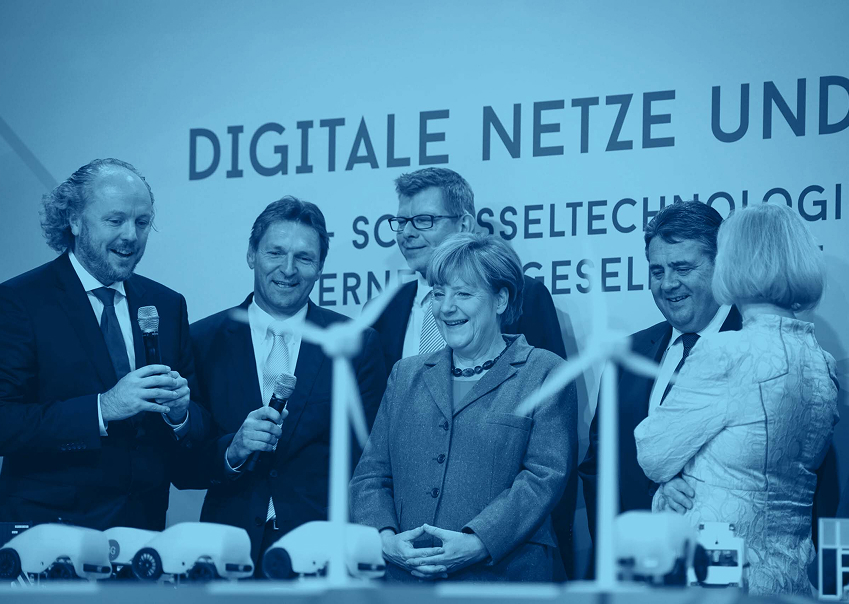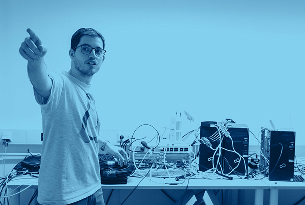Communication networks are always built to serve the people for their given needs. Currently, communication networks need to provide low latency, resilience, security and not just bare throughput. Our research philosophy can be described as “Theory that matters!”. Theoretical fundamental research results are tested using different approaches such as simulations, software in the loop, hardware in the loop, and testbeds. Importantly, implementations are not merely used to show feasibility, but rather to derive further relevant research questions by exposing theory to the real world. We apply this philosophy to all our research areas.
The chair is leading the excellence cluster Centre for Tactile Internet with Human-in-the-Loop (CeTI). In addition, Professor Fitzek is also coordinator of the 6G-life project, which is funded by the BMFTR and realized together with the Technical University of Munich.
We use testbeds to safely and effectively test new network technologies in controlled settings. This helps us repeat tests exactly and create reliable and practical solutions for telecommunications.
We are constantly publishing to share our results and insights.
Abebu Ademe Bayleyegn, Buniechukwu Njoku, Swaraj Shekhar Nande, Simon Sekavčnik, Riccardo Bassoli, Frank H. P. Fitzek
Design Tradeoffs for Quantum Time Synchronization in Future Industrial Networks under Classical Channel Latency and Security
Best Paper of the 14th IEEE International Conference on Consumer Electronics 2025, Berlin, Germany
Sifat Rezwan
Best Demo Award of the IEEE Consumer Communications & Networking Conference 2024 in Las Vegas, USA
Jonas Schulz
Caspar von Lengerke
Best Paper of the First International Workshop on Technologies for Network Twins (TNT), co-located with IEEE/IFIP NOMS 2022 Conference
Alexander Hefele
Diploma-Thesis “Examination of Identification in Software Defined Radios”, supervised by Caspar von Lengerke and Juan Cabrera
Hans-Pundt-Preis 2022 of VDE Bezirksverein Dresden
Pit Hofmann
Testbed-based Receiver Optimization for SISO Molecular Communication Channels
Best Student Paper Award at BalkanCom 2022
Stefan Senk
Flexible Measurement Testbed for Evaluating Time-Sensitive Networking in Industrial Automation Applications
Best Student Paper Award at IEEE International Conference on Network Softwarization 2022
Johannes Busch
Deep Reinforcement Learning for Traffic Control
Preis für hervorragende Diplomarbeiten auf dem Gebiet der Informations- und Kommunikationstechnologien Sächsisches Telekommunikationszentrum e.V. Dresden 2020
Roberto Torre, Goiuri Peralta, Oleksandr Zhdanenko, Alexander Kropp, Hani Salah, Giang T. Nguyen, Stanislav Mudriievskyi and Frank H. P. Fitzek
Enhanced Driving with 5G: A New Approach for Alleviating Traffic Congestion
Best Demo Award IEEE NFV-SDN 2019
Sreekrishna Pandi, Frank Gabriel, Oleksandr Zhdanenko, Simon Wunderlich and Frank H. P. Fitzek
MESHMERIZE: An Interactive Demo of Resilient Mesh Networks in Drones
Best Demo Award IEEE CCNC 2019
Tobias Waurick
Implementation of Protocol for Joint Network Coding and Compressed Sensing
FFV Master Thesis Award 2018
Frank H. P. Fitzek
5G und die industriellen Auswirkungen
Best Paper Award at 24. ITG-Fachtagung, Kommunikationskabelnetze 2017
Patrick Janos Braun, Peter Ekler and Frank H. P. Fitzek
A P2P Assisted Video Streaming with WebRTC and Network Coding
Best Demo Award at IEEE CCNC 2017
Robert-Steve Schmoll
Implementation and Evaluation of OpenStack as a Framework for easy and fast Deployment of emulated Network Environments through Resources Virtualization
FFV Master Thesis Award 2017
Robert-Steve Schmoll
Implementation and Evaluation of OpenStack as a Framework for easy and fast Deployment of emulated Network Environments through Resources Virtualization
Preis für hervorragende Diplomarbeiten auf dem Gebiet der Informations- und Kommunikationtechnologien Sächsisches Telekommunikationszentrum e.V. Dresden 2016
Juan A. Cabrera, D. E. Lucani, and Frank H. P. Fitzek
On Network Coded Distributed Storage: How to Repair in a Fog of Unreliable Peers
Best Paper Award ISWCS 2016
Mate Tomoskozi, Patrick Seeling, Peter Ekler and Frank H. P. Fitzek
Paper Performance Evaluation and Implementation of IP and Robust Header Compression Schemes for TCP and UDP Traffic in the Wireless Context
Best Paper Award ECBS-EERC 2015
The chair is leading the excellence cluster Tactile Internet with Human-in-the-Loop (CeTI). In addition, Professor Fitzek is the coordinator of the 5G Lab Germany at the TU Dresden, which encompasses an interdisciplinary team of 23 professors and almost 600 employees from various research institutes. He also coordinates the large-scale project 6G-life, which is funded by the BMBF and realized together with the Technical University of Munich.

We use testbeds to safely and effectively test new network technologies in controlled settings. This helps us repeat tests exactly and create reliable and practical solutions for telecommunications.

We are constantly publishing to share our results and insights.